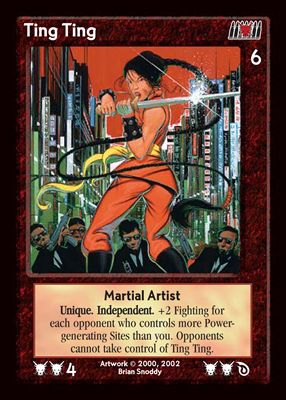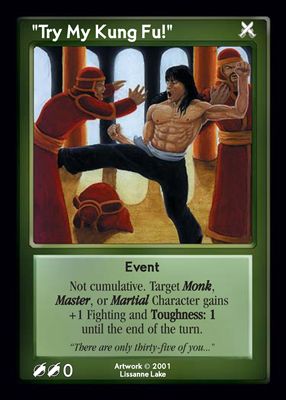There’s a Secret War going on. Warriors, traveling through the Netherworld, are battling across space and time to control the world’s Feng Shui sites. Welcome to Shadowfist. Shadowfist is a CCG that draws inspiration, loosely, from Hong Kong action movies. Players build decks from one or more factions involved in the Secret War and fight it out to see who will control the most Feng Shui sites. The goal of Shadowfist is to control five Feng Shui sites – you can play your first four from your hand, but you must take your fifth in combat.
The Secret War spans time and earth. Part of the fun of Shadowfist is the clash of time and civilization. There are ‘junctures’ that are open through the Netherworld, and Shadowfist sees cards from ancient China in 89AD, Imperial China of 1865, modern Day Hong Kong, and a post-apocalyptic 2916. Sets in the past have featured the 1930s, the 1970s, and the grim dark future of 2056.
There are ten factions that fight the Secret War. The clear good guys of Shadowfist are the Dragon, a rag-tag bunch of heroes, do-gooders, last-man-standing types. The Eaters of the Lotus are evil eunuch sorcerers from 89AD who control demons to do their bidding. In 1865 a group of monks and martial artists have formed the Guiding Hand, who seek to build a world based on Neo-Confucianism. The Ascended are animals who ascended to human form, and once controlled the world – they are a vast conspiracy: the “they” in ‘you know they say,’ ‘The Man,’ the people who fly the black helicopters. The future of 2916 is being controlled by The Jammers, a group of anarchists, rebels, and cyborg monkeys – yes, Shadowfist has cyborg monkeys. The Four Monarchs, using their sorcerous powers, rule over the Netherworld.
From 2056, the Architects of the Flesh have horrifically combined magic and technology to create abominations, and rule over the future with an iron fist. Also based out of 85AD are the Seven Masters, a sect of warrior-monks who only intervene in the affairs of others in times of extreme crisis. The Purists are a group of mathemagicians – they combine sorcery and mathematics. Lastly, The Syndicate rules the near-future through control of major criminal organizations.
In Shadowfist, you build a deck on one, sometimes more, of the factions.  There is no minimum or maximum deck size in Shadowfist, but most decks tend to be between 45 and 75 cards. You’ll have a mix of Characters, who do your fighting for you, Sites, which you’re fighting over, States, which play on your Characters to improve them, Edges, which are faction-wide bonuses, and Events: one time effects. Decks tend to be pretty character heavy, as their the main resource in the game.
There is no minimum or maximum deck size in Shadowfist, but most decks tend to be between 45 and 75 cards. You’ll have a mix of Characters, who do your fighting for you, Sites, which you’re fighting over, States, which play on your Characters to improve them, Edges, which are faction-wide bonuses, and Events: one time effects. Decks tend to be pretty character heavy, as their the main resource in the game.
On your turn, you’ll start out with an ‘establishing shot,’ where you’ll unturn your cards, generate some power – the currency in the game – and fill your hand up to your hand size. This is one of the mechanics that separates Shadowfist from other games: you always draw up to your hand size, usually six, every turn. This means you get to play as many cards as you want, or that you can, on your turn, without having to worry about saving cards for your next turn. Other players can’t really mess around with you during your establishing shot – it’s your chance to get ready for the upcoming turn.
After you finish your establishing shot, you’ll move into your ‘main shot,’ where you’ll play cards and launch attacks. In order to play cards, you’ll need both resources and power. Resources exist in a pool for you, and they aren’t used up. As long as you have X resources, you can always play cards that require X resources. Let’s take a look at Ting Ting – she requires two Dragon resources, and she also requires four power. Power is used up, but you can bank it between turns. So, if you have two Dragon resources, and you spend four power, you can bring Ting Ting into play. She has six fighting – pretty awesome!
During your main shot, you’re also going to be launching attacks. You can turn any number of characters you control to attack your opponents’ sites or characters. Attacking is the heart of Shadowfist. You declare an attack by turning your characters and designating a target. Then, moving around the table, all the other players who aren’t being attacked have an opportunity to join the attack. Then, moving around the table, all players have an opportunity to intercept your attack. Interceptors and attackers do battle by comparing fighting. A fighting score is how much damage a character can deal and how much damage they can take before they’re killed. After interceptors and attackers fight, attackers enter combat with the target of their attack. If you’re attacking a site, you’re wanting to reduce it’s body to zero, so you can claim it as your own!
 Shadowfist is specifically a multi-player CCG – something that sets it apart from almost all the other CCGs out there. It is fast-paced – it feels like the action movies it pays homage to. Characters are big, they fight fast, and the die quickly – and then more big, fast characters come back to replenish your ranks. I think my technical description may sell the soul of Shadowfist short – turns tend to be quick, with attacks flying around the table. Unexpected things happen in combat as events are played. The balance of the table can shift, quickly, and multiple times during a game of Shadowfist. This is yet another thing I love about the game – while the occasional match will see somebody run away with it, generally everybody has a shot at winning the game multiple times through play.
Shadowfist is specifically a multi-player CCG – something that sets it apart from almost all the other CCGs out there. It is fast-paced – it feels like the action movies it pays homage to. Characters are big, they fight fast, and the die quickly – and then more big, fast characters come back to replenish your ranks. I think my technical description may sell the soul of Shadowfist short – turns tend to be quick, with attacks flying around the table. Unexpected things happen in combat as events are played. The balance of the table can shift, quickly, and multiple times during a game of Shadowfist. This is yet another thing I love about the game – while the occasional match will see somebody run away with it, generally everybody has a shot at winning the game multiple times through play.
The graphic design of Shadowfist makes it easy to pick up. The cards are laid out in a simple fashion, and the relevant information is found in the same place across different card types. The art in Shadowfist is quite good, and the most recent set, Year of the Goat, had some of the strongest art to date. Those familiar with CCGs of days gone past will recognize the names of some of the earlier Shadowfist artists – names like Melissa Benson, Quinton Hoover, Mark Poole, Doug Shuler, & Susan Van Camp. The motto of Shadowfist, for as long as it’s been around, is “Equal Opportunity Butt Kicking.” This has been reflected in the art for Shadowfist over it’s twenty-year history: a diverse cast of characters has always been involved in Shadowfist, since day one.
 Let’s talk about that history. Shadowfist was first published in 1995 by Daedalus Entertainment, and they went out of business in 1996 – making Shadowfist effectively dead. In 2000 Zev Shlasinger, the Z-Man of Z-Man games acquired the licence to Shadowfist. One of the main reasons that Z-Man games was formed was to keep Shadowfist in print, and they did until 2005, when the company moved on. At that point, Shadowfist Games, a group of fans of the game, acquired the licence, and continued to put out new product. In 2013, Inner Kingdom Games released their first set of the game, and it was at this point that Shadowfist switched to a non-collectible card game model. All the sets after 2013 have been funded through Kickstarter, and backers receive all the cards in the set.
Let’s talk about that history. Shadowfist was first published in 1995 by Daedalus Entertainment, and they went out of business in 1996 – making Shadowfist effectively dead. In 2000 Zev Shlasinger, the Z-Man of Z-Man games acquired the licence to Shadowfist. One of the main reasons that Z-Man games was formed was to keep Shadowfist in print, and they did until 2005, when the company moved on. At that point, Shadowfist Games, a group of fans of the game, acquired the licence, and continued to put out new product. In 2013, Inner Kingdom Games released their first set of the game, and it was at this point that Shadowfist switched to a non-collectible card game model. All the sets after 2013 have been funded through Kickstarter, and backers receive all the cards in the set.
As you can see, Shadowfist has been mostly in print steadily since 1995, and much of that time the game has been kept alive by fans. Shadowfist fans really love the game. A lot. On more than one occasion, I’ve seen people tweet out a picture of stacks of their dead card games – which often contain a stack of Shadowfist cards. The replies to this picture quickly fill up with folks declaring “oh man, I loved Shadowfist, I wish I could still play,” or “I still have my Shadowfist somewhere.” As Shadowfist has been a labour of love by fans since the early 2000s, many simply don’t know it’s still out there.
Can I still Play Shadowfist? Yes, as I’ve outlined above, it’s still in production. There are two formats – Modern, which is all the cards produced by Inner Kingdom Games, and Classic, which is all the cards printed. The cards by Inner Kingdom Games are still in print and purchasable. Finding cards earlier than the IKG era will require some legwork, but they still exist, and are frequently on eBay.
Who Should Play Shadowfist? While there’s a two player variant, Shadowfist isn’t great at two players, so people who have a game group of at least three should check it out. You should consider checking it out if you are a fan of action movies, especially Hong Kong action movies, or if you enjoy fast-paced games where the balance of power at the table shifts frequently.
Who Shouldn’t Play Shadowfist? The biggest turnoff to Shadowfist for many people is the timing structure. Shadowfist’s timing operates on a first-in-last-out stack, and if you don’t grok this at first, the game can be frustrating. You win Shadowfist by taking your opponents’ sites, so if you don’t like take-that style games, it might not be fun for you.
As a newcomer considering the latest Shadowfist kickstarter, this is a useful extra perspective on the game and whether it would work for me and my local friends.
Thanks!
Thanks so much, Tyler!